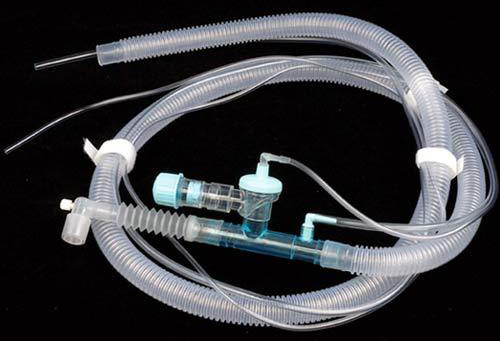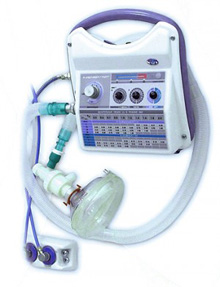Categories
Ventilator Circuit

Artificial lung ventilation (ALV) was introduced into clinical practice in 1929 in order to “provide opportunities for all patients with impaired respiratory function to restore normal breathing”. This procedure has been used as a selective lung ventilation method in some pathological conditions for a long time.
Auxiliary ventilation allows the patient to maintain spontaneous breathing. Auxiliary lung ventilation can be considered as an interim stage between traditional artificial lung ventilation and adequate independent breathing.
The main task of anesthetic equipment of any complexity is to provide respiratory functions of the organism, i.e. effective gas exchange in conditions of separate or artificial respiration. Breathing circuit provides oxygen and anesthetics administration from anesthesia apparatus into the respiratory tract (lungs) of a patient and removal of this expiratory mixture. There are two main types of ventilator circuits: with and without the reversion of gas mixture. Reversion means full or partial rebreathing of the anesthetic gas that has already been exhaled. The simplest systems are nonrebreathing ones, which do not use the expiratory mixture again and depend on the level of fresh gas flow. Several models of such systems are described by Mapelson and are still used in some areas of anesthesiology, for example in pediatrics. However, in order to prevent the accumulation of CO2 in the circuit a flow of fresh gas is required, which exceeds minute pulmonary ventilation at least twice.
Depending on what the gas vessel is – atmosphere, a breathing bag or a bottle of anesthesia apparatus – the circuit can be called open or semi-open. In any case, the exhaled gas fully goes into the atmosphere. The device provides the supply of feed mixtures containing a great amount of oxygen and the ability to use inhalation agents. The advantage of such systems is their light weight and handiness. The disadvantages are the excessive consumption of oxygen and anesthetics, pollution and large losses of heat and moisture.
LTV 1200
This light, compact and multifunctional device is designed for prolonged artificial lung ventilation. Function “Ideal patient’s weight” preinstalls ventilation modes for adults, children and neonates. A built-in turbine provides the necessary air flow.
The connection of oxygen is possible at a pressure of less than 1 atms.
Works from the internal battery, in vehicle network and AC network.
Minimal patient’s weight is 5 kilos.
There are different types of staff fastening: on a mobile cart, a table stand, on bed and stretcher clamps.
A shoulder belt or a backpack will help you to transport the device.
The apparatus possesses all modern ventilation modes (VCV, PCV, SIMV, PEEP, PS and spontaneous respiration)
The simplicity of management and operation allows you to use it even at home, but it is not recommended.
LTV 1000
Designed for long-lasting artificial ventilation of lungs for neonates, children and adults in the department of intensive therapy and reanimation, in recovery rooms and for the transportation of sick people.
The device is equipped with a color touch-tone monitor, which allows simultaneous display of ventilation settings, breathing curves, loops and trends within 24 hours.
Ventilation modes: PCV, A/C, SPONT, CPAP, APNЕА ventilation, noninvasive ventilation, manual ventilation.

LTV 1150
Whether patients are in an emergency room or in a hospital, model LTV 1150 will help them to go home. LTV 1150 and LTV 1200 possess similar characteristics, but LtV 1200 is applicable only in hospitals. LTV 1150 supports a range of various functions, including SBT and PEEP. Because of them the device is light and has smaller dimensions.
Characteristics:
Minimal weigh of a patient – 5 kilos.
Patient’s type can be chosen: Adult, Neonate.
Handy interface.



